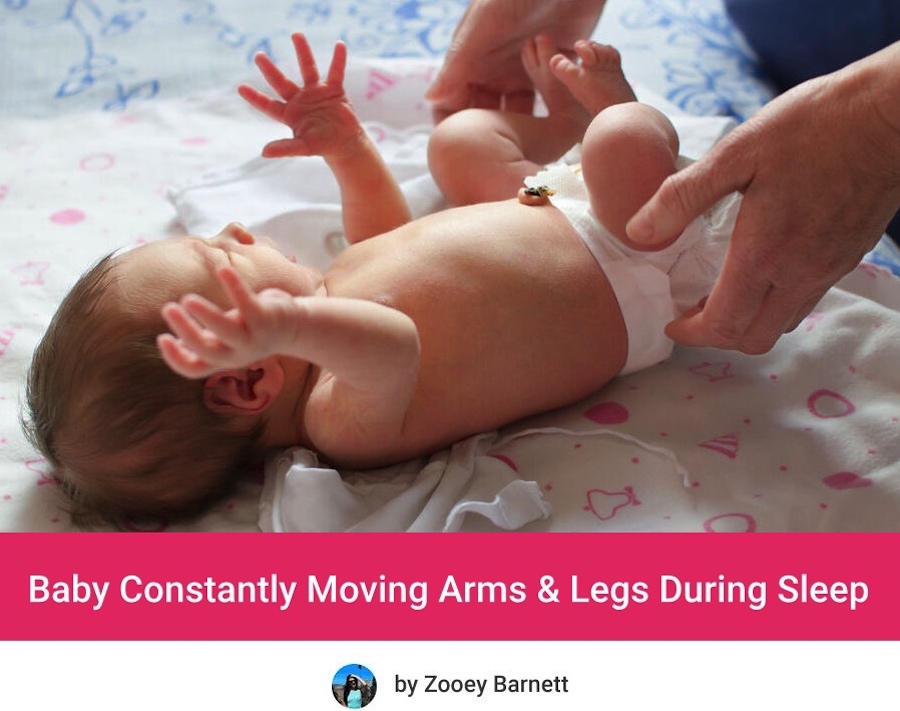
Picture this: you’re swooning over your perfect little newborn sleeping peacefully, and the next second, you see your baby flailing arms and legs during sleep.
For most parents, especially new parents, you might worry and your survival instinct kicks in to protect your little bubba.
Are they troubled by a bad dream…?
Are they trying to signal something…?
Are we doing something wrong…?
Let me start by saying that this is absolutely normal! Yes, read that again.
A baby flailing arms and legs, before sleep or while sleeping is completely normal, and it’s actually an indicative of their brain being active. It could be due to the baby’s Moro reflex (explained below) – one of the normal reflexes of newborns where they startle, as if they are falling.
If you’re looking to figure out how to keep your baby calm and help them sleep better, read on to find out.
This article is not a substitute for medical advice or consultation.
Why Is My Baby Flailing Arms And Legs At Night?
Once you know the possible causes for your baby flailing arms and legs during their sleep, you can help your baby sleep and have a good night’s sleep yourself too. (win-win situation!).
Here are the most common causes that might be the reason for your baby’s movement at night:
1. Milestones & Development
All parents will agree in a heartbeat that watching their children achieve their developmental milestones brings joy like no other. It’s so rewarding to see your child grow.
One of the early milestones is muscle strength and most babies flail their arms and legs to build muscle power. It helps your baby’s body to get familiar with balance and coordination.
Next time you’re wondering why your baby is flailing their arms and legs, keep this in mind to keep your anxiety at bay. These reflexes and milestones1 are a sign that your baby is doing great. Yay!
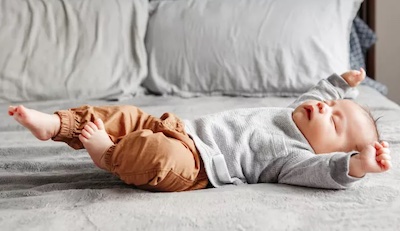
2. Moro Reflex
One of the newborn reflexes is the Moro reflex, a.k.a. the startle reflex or embrace reflex.
Have you ever noticed your baby startle themselves in their sleep and start to cry? Your baby’s Moro reflex is to blame. Most babies stretch and open their arms as if free falling, often followed by curling their arms and legs back toward their bodies.
Though it may seem unsettling, this is actually an indicator of your baby’s development.
Moro reflex shows that your baby’s nervous system is growing well. It can be triggered by a loud noise, bright light, or sudden movement2.
As the newborns gain muscle strength, the Moro reflex starts to disappear and diminishes completely around 5-6 months. If it doesn’t, there might be a delay in motor skills development, so please discuss it with their doctor.
Sometimes, your newborn might even startle awake due to the Moro reflex. You can try swaddling them as the baby feels protected in the swaddle and it mimics the coziness of the womb. Being an effective technique, swaddling can help your baby fall asleep. Plus, it also helps babies to self-soothe and learn how to sleep on their own.
Remember to stop swaddling once your baby seems to be trying to roll over to avoid sleep dangers (overheating, suffocation, or SIDS).
By the way, another newborn reflex is rooting reflex that may cause your baby to rub their face on you. It’s also a sign of normal development!
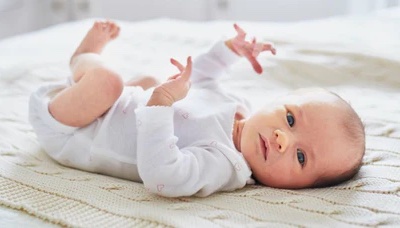
3. Restless Sleep
In the first few months, restless sleep and newborn babies go hand in hand.
This is because their sleep cycle differs from ours. Though restless sleep can be attributed to various causes such as wet nappy or hunger, the discomfort can have your baby stirring in sleep and they start flailing their arms and legs.
Once their needs are met, they’ll go back to sleep. Mostly.
4. Overstimulation & Tiredness
Babies often flail their arms and legs when they are overstimulated or fatigued. It can also happed when baby is overtired.
When your infant has extra energy left at the end of the day, they will constantly move their arms and legs to release it. This helps them settle down and falling asleep becomes easier.
As babies grow up, you might notice that they seem to be irritable and overstimulated if they skipped nap time. This can also result in the baby kicking legs and flailing arms. No crying, if you’re lucky!
You can try to build a sleep routine that you follow religiously every day, preferably in the same environment. Once the babies get used to it, it might help to improve, if not disappear, their flailing movement, as your infant will get enough sleep.

5. Gassy Babies
Many parents notice that their infants stop flailing once they passed wind or were picked to burp. So if your baby has constipation or gas, this might cause the little one some discomfort, resulting in movement while sleeping.
6. Other Stimuli
As newborns take some time to get accustomed to the outside world, they might jolt themselves upon exposure to various stimuli such as loud sounds, light exposure, or sudden movements.
Avoid loud sounds and sudden jerky movements around them and keep your baby close if they are awake (rock them gently) to help them fall back to a sound sleep. Swaddling can soothe your baby and help them fall asleep again.
7. Medical Conditions
Your infant could be flailing their arms and legs due to some underlying medical condition. Make sure to keep an eye out for any change or increase in your baby’s movements and breathing.
Some medical conditions that could be the cause behind a baby’s flailing arms and legs are a neurological disorder (cerebral palsy or epilepsy), sleep disorders, infections such as meningitis, or even skin issues like eczema.
If infants are itchy, they are quite likely to stir in their sleep and flail their legs and arms. This is because of the uneasiness from eczema. If your newborn keeps wrestling their way out of their swaddle, it could be due to the itchiness.
8. Sleep Disorders
Sometimes, a baby’s arms and legs flailing could be a sign of sleep disorders.
Apart from normal sleep movements in babies, there can be movements due to sleep disorders such as REM sleep disorder, restless leg syndrome (quite rare among newborns), or periodic limb movement disorder. Older children experience sleep talking, moaning, and even trembling and sweating with night terrors.
Try to stick to a sleeping routine to establish healthy sleeping habits and discuss any concerns you might have with their healthcare provider on your next visit.
Baby Flailing Arms And Legs – Is It Normal?
Yes, it is completely normal for a baby to flail their arms and legs. It means their nervous system is developing and working just fine.
As mentioned above, it could be simply physiological i.e. the Moro reflex or the startle reflex. Other reasons include restless sleep, medical conditions, sleep disorders, gas or constipation, overstimulation, etc.
Though it can worry many parents, it all pans down to identifying the root cause and helping your baby fall back to sleep, so they can get the adequate rest they need to grow and explore the world.
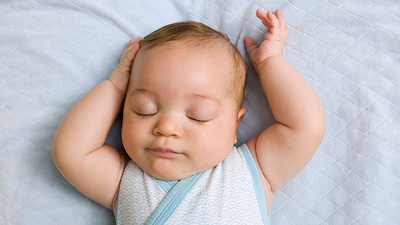
Baby Kicking Legs And Flailing Arms In Sleep – What You Can Do About It
Here are a few pointers to help your baby if they are kicking legs and flailing arms in sleep:
1. Swaddling
The best way to soothe and help your baby fall asleep if they flail their arms and legs is to swaddle them. In case you don’t know, a swaddle is a thin blanket or cloth that you wrap around your baby to mimic the cozy embrace of the womb.
This helps babies feel protected and decreases the chances of startling themselves awake during their sleep due to the Moro reflex/startle reflex.
If you find your baby’s arms out of the swaddle whenever they wake up, try wrapping the swaddle around your baby with their arms out.
Remember, the swaddle should be snug and comfortable, not too tight around the baby’s hips but instead allowing enough space for them to assume their natural frog-leg position (ideal for baby’s development).
If your baby starts to show signs of rolling over, avoid swaddling because it could present the risk of overheating (damp hair, excessive sweating, rapid breathing) or suffocation, as babies move around a lot and any loose clothing can be dangerous.
If your baby doesn’t really like being swaddles, read my article here to find out what to do when baby hates swaddle.
2. Sleep Routine
Try to establish a sleep routine and make sure you stick to it so your baby can develop good sleeping habits3. Make sure you start winding the baby down at the same time every day and in the same environment, so they can get accustomed to it. This helps reduce excessive movement during sleep.
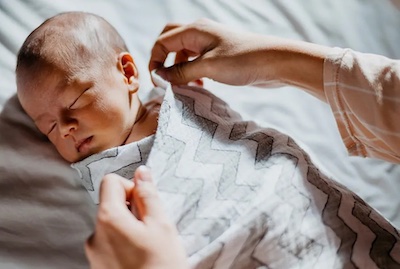
3. Calming Techniques
More often than not, babies and children have a lot of extra energy by the end of the day or they might be overstimulated. Use soothing techniques such as body massage, warm baths, a white noise machine, and lots of hugging, rocking, and cuddling before bedtime to make sure your little one is ready to go down for a good night’s sleep.
4. Alleviate Gas/Constipation
Make sure to burp the baby before putting them to sleep. Make sure they have passed wind with a gentle abdominal massage, some stretching, and by gently tucking their knees up to their chest. This little exercise helps alleviate gas, and colic and lets the baby sleep easily.
Always remember to separate feeding from sleep so the baby can sleep better and longer without being gassy.
5. Proper Positioning For Moro Reflex
If your baby is under 5 months, chances are their Moro reflex is still going strong. Position them horizontally in their bassinet/crib and make sure their head does not tilt to avoid startling them awake. Always make sure to touch their feet first in the crib, then their bum, and then the head, to avoid triggering the Moro reflex.
6. Seek Medical Advice
If your baby has some underlying medical issues or concerns, get it checked by a healthcare professional as soon as possible. Remember, healthy babies sleep better and are happier! So if your baby shows any signs or symptoms of some medical issue4, especially breathing, have it looked into urgently.
Could Your Baby Get Hurt When Kicking Legs And Flailing Arms?
Yes. Kicking legs can lead to cuts, bruises, and even shattered bones. Make sure to put them in a safe sleeping space with no obstacles that could hurt them. Moving too much might even result in them falling from their crib, if not protected well.
Other than that, their excessive movement can put them at risk for suffocation, overheating or God forbid, SIDS (sudden infant death syndrome) in the presence of loose clothing or blanket.
Remember to keep an eye out if your baby is moving around before bed and keep them safe.
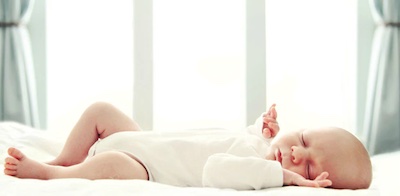
Flailing Arms And Legs At Night – Does It Affect Baby’s Sleep Cycles & Sleep Quality?
Yes, it does.
Since babies’ sleep cycle is different from adults, they keep transitioning in and out of REM sleep. This means they keep shifting from light sleep to deep sleep quite easily as compared to grownups.
Apart from their shorter cycles, they experience the Moro reflex just before sleeping. Though it is a normal neonatal reflex (just like the rooting reflex, tonic neck reflex, etc), it can disrupt your baby’s sleep and wake them up from sound sleep.
It is important to ensure your child isn’t excessively tired or stimulated to ensure a night of good sleep and less flailing.
When Do Babies Stop Flailing Arms And Legs?
The Moro reflex goes away around 5-6 months of age. Other than that, repetitive behaviors in an infant child go away around when they are 12 months old.
If the flailing persists, seek medical advice for underlying health concerns.
How To Calm The Baby When They Experience Moro (Startle) Reflex
As you may know by now, the Moro reflex is one of the neonate reflexes where your baby has a free-falling sensation and they flap their arms and kick their legs. Though the Moro reflex is a sign that your baby is developing well, it can wake your baby from their sleep due to the motion and disturb them.
Here are a few tips to calm infants when they experience the Moro reflex:
- Swaddling: As swaddling restricts movements, it allows babies to fall asleep easily after they experience the Moro reflex. Remember to ensure the baby’s safety while swaddling them.
- Horizontal positioning: Make sure you place them feet-first and horizontally in their crib/bassinet. This prevents their head from being tilted and triggering the Moro reflex.
- Avoid triggers: Moro reflex can be triggered by various external stimuli. Avoid bright lights, loud noise, cold touch, and sudden jerky movements5.
- Be gentle: I know that as a parent you are worn out by the end of the day, but remember that Moro reflex can be unnerving for your child, so be empathic and soothe your baby as they face this free-falling sensation.
The purpose of this article is informative. It’s not a substitute for professional medical advice or medical care. Remember: safety first! Consult your doctor/pediatrician in case of any doubts. The author of this article does not accept any responsibility for any liability, loss or risk, personal or otherwise, incurred as a consequence, directly or indirectly, from any information or advice contained here.
Resources:
https://koalababycare.com/
https://www.nestedbean.com/
https://dreamlandbabyco.com/
https://www.seattlechildrens.org/
https://www.childrens.com/

